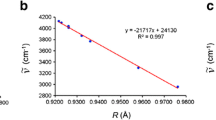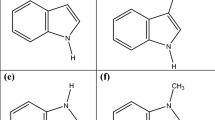Abstract
Within the framework of the one-parameter theory of vibronic activation (OVTA), vibronic constants have been determined for the ground, ionized, and excited electronic states of the hydrogen molecule. Charge transfer and changes in energy of the H-H bond were calculated in the interval of stretching vibrations from 2200 to 4400 cm−1, covering all cases of coordination of both σ- and π-complexes. It has been shown that breakdown of complexes with molecular hydrogen takes place at IR spectral frequencies of 2200–2400 cm−1. The results obtained in this work are in good agreement with experimental data.
Similar content being viewed by others
Literature cited
I. B. Bersuker and S. S. Budnikov (Budnicov), Proceedings of 4th International Conference on Homogeneous Catalysis, Leningrad, 1984; published by Gordon and Breach, London (1984), Vol. 2, pp. 557–558.
S. S. Budnikov, Izv. Akad. Nauk Mold. SSR, Ser. Biol. Khim., Nauk, No. 1, 50 (1988).
I. B. Bersuker, S. S. Budnikov, and A. P. Svitin, 5th International Symposium on the Relation between Homogeneous and Heterogeneous Catalysis (Summaries of Papers), Novosibirsk, July 15–19, 1986; published in Novosibirsk (1986), p. 35.
G. J. Kubas, Acc. Chem. Res.,21, 120–128 (1988).
H. Rabaa, J. J. Saillard, and R. Hoffman, J. Am. Chem. Soc.,108, 4327–4333 (1986).
J. Silvestre, M. J. Calhorda, R. Hoffmann, et al., ibid.,5, 1841–1851.
A. P. Svitin, S. S. Budnikov, I. B. Bersuker, and D. V. Korol'kov, Teor. Éksp. Khim.,18, No. 6, 694–700 (1982).
I. B. Bersuker, S. S. Budnikov, and A. S. Dimoglo, Kinet. Katal.,23, No. 6, 1454–1460 (1982).
G. E. Gadd, R. K. Upmacil, J. Polliakoff, and J. J. Turner, J. Am. Chem. Soc.,108, 2547–2552 (1986).
Author information
Authors and Affiliations
Additional information
Translated from Teoreticheskaya i Éksperimental'naya Khimiya, Vol. 28, No. 1, pp. 34–38, January–February, 1992.
Rights and permissions
About this article
Cite this article
Budnikov, S.S. Activation of molecular hydrogen upon coordination: The vibronic approach. Theor Exp Chem 28, 31–35 (1992). https://doi.org/10.1007/BF01006990
Received:
Issue Date:
DOI: https://doi.org/10.1007/BF01006990




